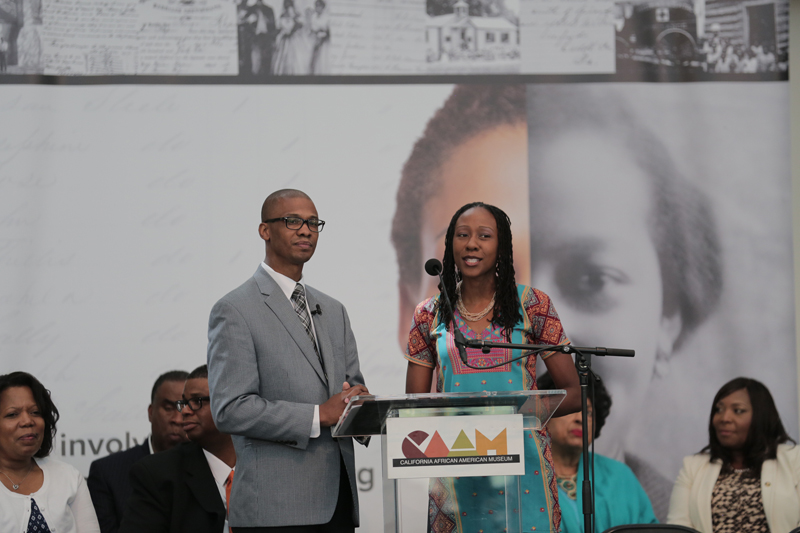
Jermaine Sullivan and his wife, Kembe, both featured in the movie “Meet the Mormons,” conduct a media event in Los Angeles to announce the Freedmen’s Bureau Project, on June 19, 2015. Photo courtesy of the Church of Jesus Christ of Latter-day Saints.
Last Friday, on the 150th anniversary of “Juneteenth,” the LDS Church unveiled its ambitious plan to index more than four million genealogical records of former slaves.
It’s an amazing undertaking. (Click here to find out more about the project overall and here if you’d like to volunteer to be part of it. You can log on from anywhere.) Once the records have been indexed, African Americans who are researching their family history will be able to access crucial information that was virtually unobtainable before.
So, the good news is that the Church is funding this effort and providing the human hours to see it through. And there’s internal progress afoot too: African American Mormon leaders were in attendance at Friday’s press conference, including LDS Stake President Jermaine Sullivan and his wife Kembe.
But this last week has also seen criticism of the way the LDS Church has addressed – or, more accurately, not addressed – race relations.
At the Huffington Post, for example, political science professor Benjamin Knoll took a dim view of the Deseret News’s recent editorial about the Charleston shootings, which downplayed the racial motivation for the murders in favor of blaming “a rising secularism that would limit religious expression.” In his brief article “No, the Charleston shooting was not an attack on ‘religious freedom,’ Knoll wrote:
As was so completely and obviously apparent from the beginning and has been made even more clear in the aftermath, Dylann Roof did not commit this act of murder out of a secular hatred for religious freedoms or religious Americans. He did this because he hates black people.
As much as some conservative Christians feel that their religious liberties are being threatened by secular society these days, their struggles pale in comparison to the systematic prejudice and discrimination still regularly experienced by racial minorities in the United States on a daily basis. To try to twist this story into a “religious liberty is under attack” narrative is not only completely tone deaf and self-serving, but shows an extreme lack of sensitivity and respect to the families of the shooting victims.
I’m sure that the authors of the Deseret News editorial (which, in its defense, also mentioned the “irrational scourge of racial hatred”) feel deep sympathy for the victims of the Charleston shooting. But Knoll is basically right: even well-intentioned words, ones that seek to create a sense of camaraderie between Mormons as a religious minority and African Americans as a racial minority, utterly miss the point.
White Mormons, who are still by far the majority of Latter-day Saints in the United States despite the Church’s growing diversity abroad, live in a bubble of racial privilege.
It’s white privilege that enabled the Church to take no notice of the June 8 anniversary of the 1978 announcement that allowed blacks to enter the temple and be ordained to the priesthood. As Julienna Viegas-Haws noted in a wounded Salt Lake Tribune editorial on Saturday, Mormons devote all kinds of attention to our July 24 Pioneer Day and almost none to the landmark reversal of the policy that once prevented her and her family from the full blessings of Church membership.
It’s white privilege to bury the Church’s excellent “Gospel Topics” essay on race – one that carefully positions the policy as arising in “a highly contentious racial culture in which whites were afforded great privilege” – deep in the bowels of the Church’s website rather than requiring that it be read aloud from the pulpit and taught in Sunday School.
Until that happens, many white Mormons will persist in perpetuating theological untruths about the all-too-human reasons for the ban. I’ve had commenters right here on this blog insist that the priesthood ban was of the Lord, and not the result of LDS leaders being culturally conditioned by the racism of their times. The Church has already released a statement that clarifies this matter significantly . . . but not nearly enough people know about it. (Some great news posted yesterday about the new curriculum for youth suggests that this neglect may be changing, and that the GT essays will be incorporated more fully into LDS lessons.)
And white privilege was on full display in many U.S. wards on Sunday as they ignored last week’s Charleston shooting. It’s been interesting to see the informal polls and discussions online about whether local leaders addressed the murders, took the opportunity to denounce racism, or even prayed for the victims and their families.
Some did. Most apparently did not.
So, I’m glad the Church is working on the Freedmen’s records — and that, at the announcement, Elder Christofferson did take a moment to publicly condemn the Charleston hate crime. It was an excellent example.
There has been much progress. But there is still a very, very long way to go.





